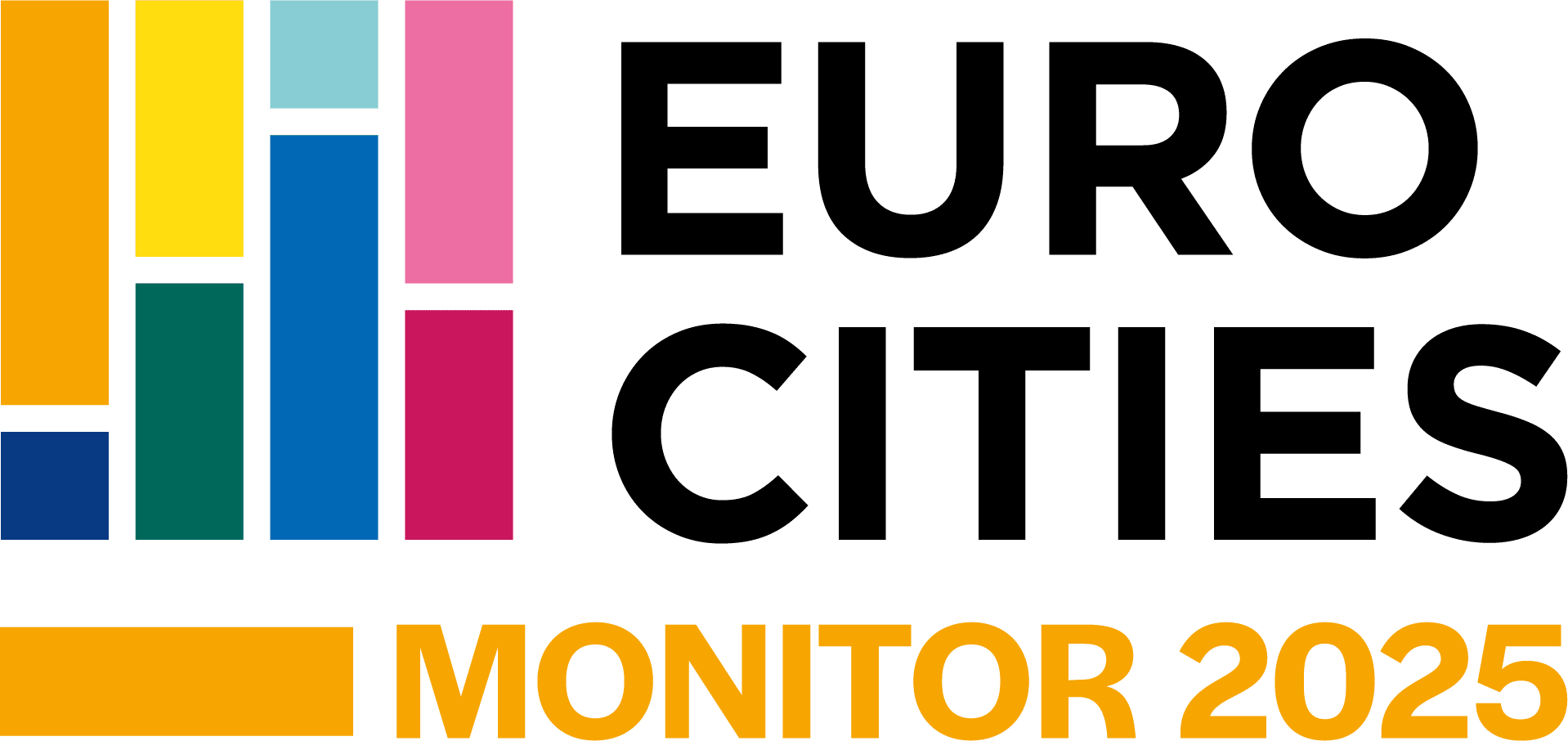Taking the pulse of European mayors

The Eurocities Pulse Mayors Survey is the flagship annual survey carried out across the broad membership of Eurocities, which brings together most of the major European cities, representing over 150 million people all over Europe. Drawing on 86 responses from leaders among Eurocities’ 222 member cities across Europe, this third edition aims to once again ‘take the pulse’ of mayors, gauging their perceptions of major topics on the agendas of European and local leaders.
What you will read here is the result of a selection of the main findings of the Eurocities Pulse, with further analysis of the data to follow.
Contents
The Eurocities Pulse Mayors Survey is the flagship annual survey carried out across the broad membership of Eurocities, which brings together most of the major European cities, representing over 150 million people all over Europe. Drawing on 86 responses from leaders among Eurocities’ 222 member cities across Europe, this third edition aims to once again ‘take the pulse’ of mayors, gauging their perceptions of major topics on the agendas of European and local leaders.
What you will read here is the result of a selection of the main findings of the Eurocities Pulse, with further analysis of the data to follow.
Contents
Looking forward: top priorities for mayors for 2025
Climate action remains mayors’ top priority in 2025, with well over half of mayors selecting it for the third year in a row. Despite reduced political support from the EU institutions, mayors are keen to continue implementing actions related to both climate adaptation and climate mitigation. In their responses, mayors highlight cities’ central role in leading climate action in many diverse ways, including enhancing biodiversity, energy efficient building renovation and improving air quality. Mayors also recognise the importance of working with business leaders and private industry to invest in key areas such as renewable energy and urban greening.
Top 10 priorities for 2025
Top 10 priorities for 2025
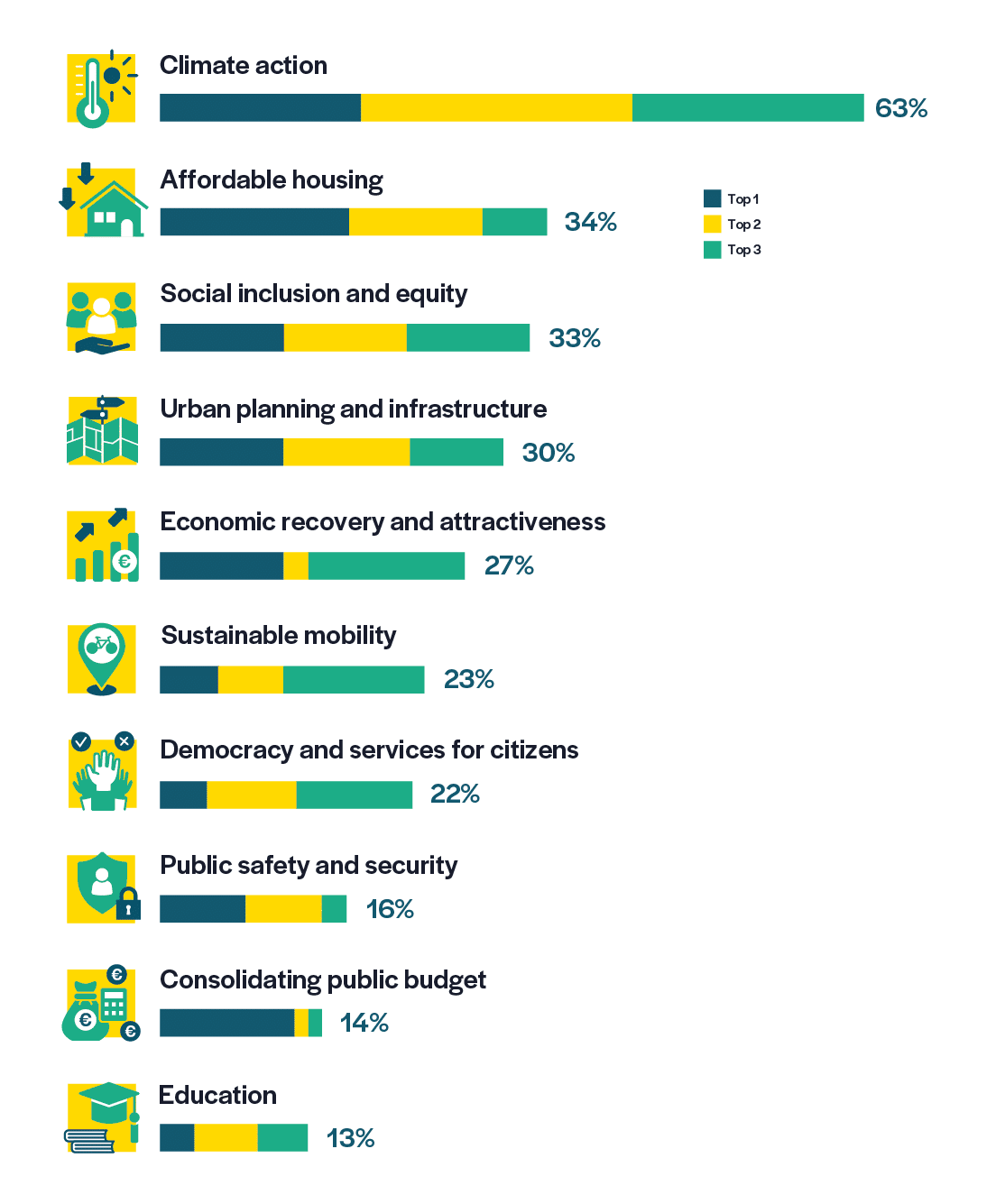
Jumping up into second place, from third last year, is affordable housing, with more than one in three mayors selecting it as a top priority. Interestingly, this year affordable housing is the number one priority for one in six mayors, twice as many as last year. While housing is not an EU competence, the immediacy of the housing crisis makes it clear that EU action to support cities is a priority.
In their reflections, mayors from geographically disparate cities such as Budapest, Zurich and Barcelona all highlight measures to increase the supply of social and affordable housing, prevent gentrification and regulate short-term rentals. Strategies include public-private partnerships, municipal housing funds, urban revitalisation projects and regulatory measures to protect tenants. Some mayors specifically cite their efforts to integrate housing policy with climate action by promoting energy-efficient renovations.
Social inclusion and equity remains a critical priority for 2025, coming in a close third after affordable housing. Many mayors are prioritising reducing social disparities, tackling segregation, and strengthening community ties. Efforts include expanding social services, fostering intergenerational connections, increasing support for marginalised groups, and improving access to education, employment, and cultural activities.
Urban planning and infrastructure rises into the top four, up from fifth place last year, increasing significantly from 24% to 30.2%. Through their reflections, mayors highlight the need for investments in strategic urban development projects to ensure sustainable growth, resilient infrastructure and efficient public services. Recognising the need for new developments to reflect their sustainability goals, mayors highlight work to modernise roads, water systems and waste treatment facilities, but also promote green urban planning.
Economic growth and attractiveness is also on the rise, leaping from eighth place last year to round off this year’s top five, increasing from 15% to 27%. With rising economic uncertainty and a renewed EU focus on competitiveness through initiatives like the Clean Industrial Deal, cities are stepping up on job creation, investment attraction and financial resilience. Mayors highlight their efforts to stimulate local economies through innovation, digital transformation and strategic industries. Some cities are supporting industrial competitiveness and business-friendly environments, while others focus on the blue economy and technology hubs to diversify their economic base.
Sustainable mobility, on the other hand, drops slightly in order of importance, moving from last year’s top four to this year’s top six, decreasing from 28% to 23.2%. To achieve climate goals and improve urban quality of life, cities are prioritising public transport, active mobility, and clean mobility solutions. Some are expanding cycling infrastructure and low-emission transport options, while others focus on integrated digital mobility platforms and multimodal systems (see special section on mobility). Cities are also exploring new funding mechanisms and public-private partnerships to support transport investments.
Democracy and services for citizens is also on the rise this year, rising into seventh position (up from ninth place in 2024), significantly higher than the previous year. In the current geopolitical context that throws a shadow over our democracies, mayors are keen to strengthen citizen participation, local governance, digitalisation of public services, and transparent decision-making as a means to increase citizen trust in public institutions.
Public safety drops from sixth position last year to eighth, with a slightly lower percentage of mayors highlighting it (16.2%). Mayors are addressing security challenges such as crime prevention, cybersecurity and crisis resilience.
Consolidating public budgets moves up one place to ninth this year. Budget constraints due to inflation, rising energy costs, and social spending are forcing cities to prioritise financial sustainability. Cities are working to balance budgets while maintaining essential services, focusing on cost-saving measures, smart financial planning, and securing EU funding.
Closing out this year’s top ten, and a new entry in the ranking, is employment, skills and education. Investing in education, skills development, and youth employment is a key concern for cities. Cities are focusing on reducing educational inequality and improving vocational training. At the same time, others are fostering partnerships between businesses and educational institutions to address skills gaps.

Looking back: unexpected top challenges faced by mayors in 2024
In 2024, city leaders across Europe faced unexpected challenges that significantly impacted their ability to meet strategic goals. Financial constraints and budgetary pressure were the most frequently cited challenges in 2024, with more than a third of mayors (34%) highlighting their unexpected impact.
Budget shortfalls and rising costs have made it increasingly difficult for cities to maintain essential services and invest in strategic projects. Mayors report that national governments have imposed spending cuts or failed to provide sufficient financial resources to match growing local government responsibilities.
Some city leaders also experienced lower-than-expected tax revenues, delays in EU or national funding, and rising costs of public services due to inflation. Financial pressure is forcing cities to delay or cancel investments in housing, infrastructure, sustainability, and public services. City leaders expect the next EU budget to address this so that they can fully deliver on crucial EU policies such as the European Green Deal and drive innovation and social inclusion.
Top unexpected challenges faced by mayors in 2024
Top unexpected challenges faced by mayors in 2024
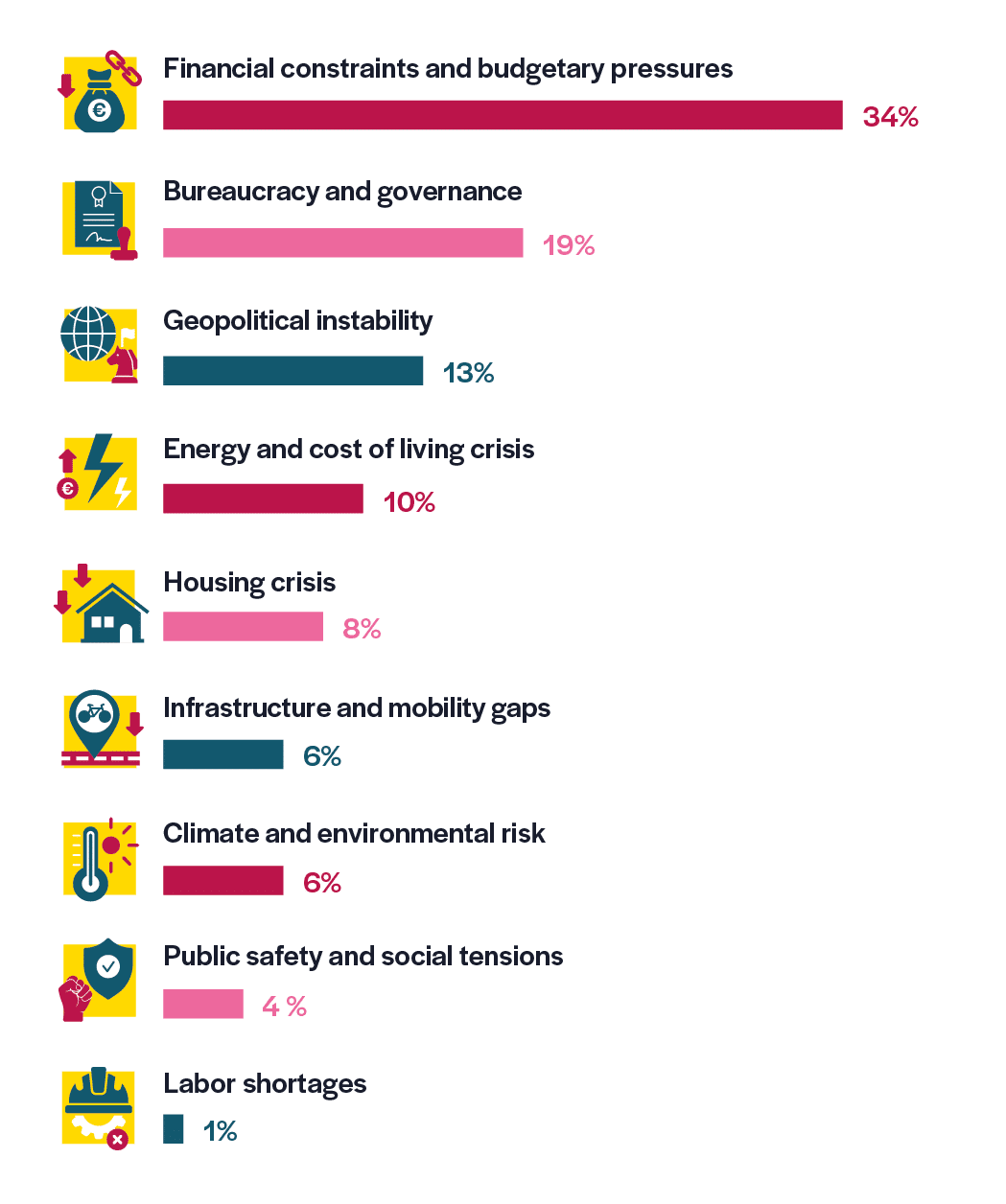
Overall, the majority of the top 10 challenges cited by mayors reflect challenges of global current affairs, in one way or another, showing how interlinked local politics is with other levels of government.
Geopolitical instability and the impact of war were prominently mentioned by mayors. The ongoing impact of Russia’s war in Ukraine and conflicts in the Middle East have placed an economic, social, and political strain on cities. Cities are absorbing large numbers of displaced people, leading to pressure on housing, infrastructure and social services. Some cities have reallocated budgets to integration, security and defence measures, reducing funding for other strategic priorities. In the face of these challenges, mayors highlight the importance of reinforcing emergency preparedness.
The housing crisis and rising costs of living have been a major challenge for many mayors, mentioned by close to one third of them. Housing shortages, rising rents and affordability issues are growing year on year, leading to a real emergency in many cities, deepening social inequalities and forcing cities to rethink their policies. Many mayors are diverting resources and political focus to this multilayered crisis, which now touches middle-income residents in many cities. Cities have struggled to build enough social and affordable housing due to limited funding, rising construction costs and regulatory obstacles. Tourism and gentrification have exacerbated the housing crisis in some cities. Without adequate housing, mayors face increasing pressure on social services and risk losing economic competitiveness.
Bureaucracy and regulatory hurdles have slowed down urban development actions for many mayors, who cited it as a major unexpected challenge. Bureaucratic obstacles, slow national approvals and fragmented governance structures are delaying major urban projects related to infrastructure such as waste management. Cities feel trapped in rigid funding and administrative structures that do not allow them to act swiftly. Linked to this, some city leaders highlight how political uncertainty, government coalition breakdowns, or national-level policy shifts delayed decision-making and disrupted project funding.
Unexpected climate and environmental challenges remain a key issue for mayors, with extreme weather events, pollution and environmental degradation increasingly disrupting urban life. Cities are facing flooding, droughts, and heatwaves, which require costly interventions and adaptation measures. In their responses, mayors highlight that despite being at the forefront of climate adaptation measures, they lack the resources to fully prepare for future environmental risks, and some highlight further challenges such as reduced funding, or inconclusive political discussions at the national level.
Labour shortages and workforce retention were also highlighted by several cities, particularly in the public administration, education, construction, and social services sectors. This is something that is slowing down project implementation and increasing operational costs, and something that will be exacerbated by demographic shifts, ageing populations, and competition for talent. Mayors look to the EU’s focus on skills to ensure cities needs will be recognised, allowing them to act as competition trailblazers.
Rising costs and inflation continue to put pressure on municipal budgets. City leaders highlight how they have faced unexpected increases in material and construction costs, leading to delays or reductions in planned investments for housing, infrastructure, and sustainability projects. Inflation has also made it more expensive to maintain public services, forcing some cities to reprioritise budgets at the cost of long-term development goals.

Mayors delivering impact: spotlight on 2024 achievements
Despite the challenges of 2024, mayors across Europe have demonstrated bold leadership in tackling local, national, and global issues. From innovation and sustainability to housing and mobility, city leaders have stepped up to deliver meaningful change. Their achievements highlight the power of city leadership in shaping Europe’s future and reinforce that cities are at the forefront of solutions.
Mayors have shared the single achievement they are most proud of in 2024 – showcasing their role as problem-solvers, visionaries, and enablers of transformation. Their successes reflect their commitment to improving the lives of residents, strengthening their economies, and making their cities more resilient.

Top achievements of mayors in 2024
Top achievements of mayors in 2024
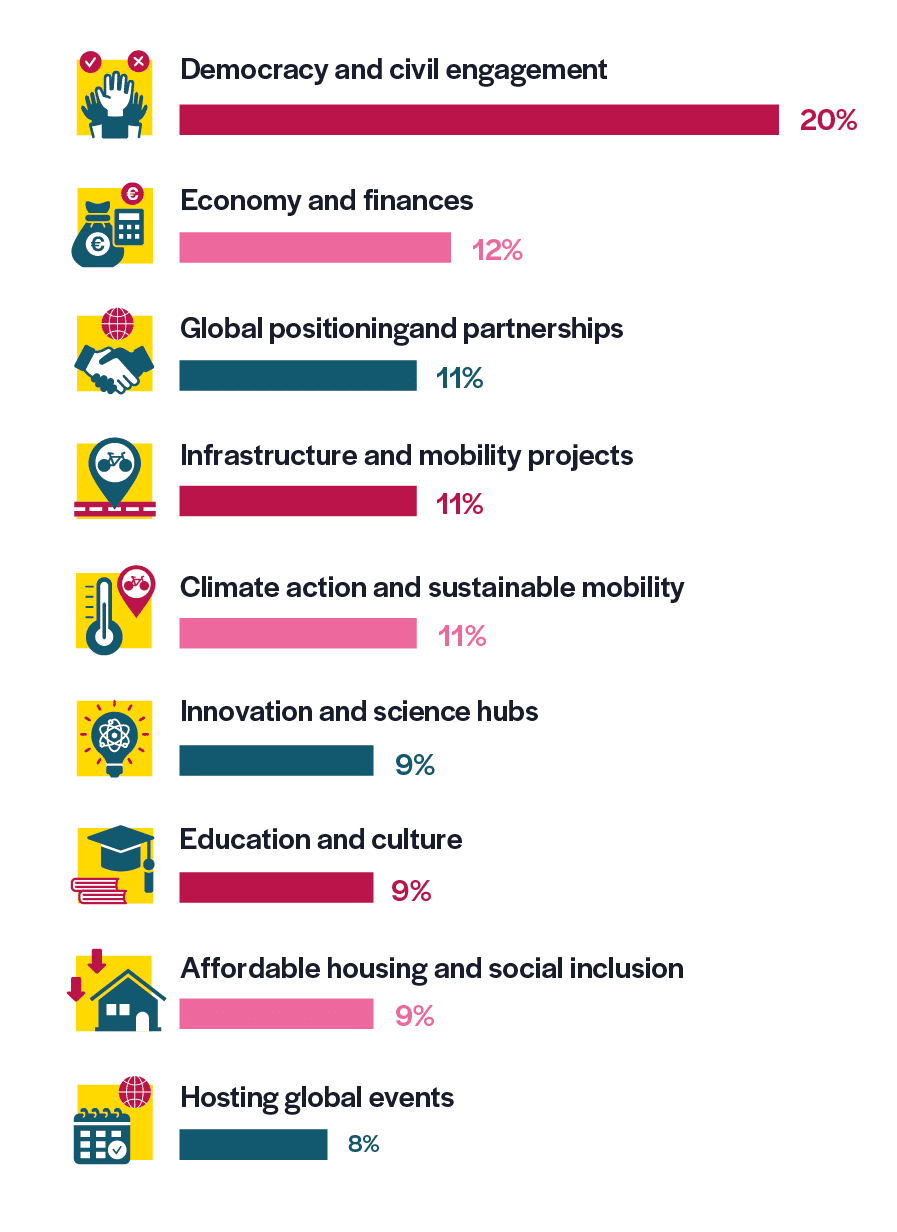
Climate action and sustainable mobility are some of the areas where most mayors feel they have made a difference last year. Many mayors have led efforts to decarbonise their economies, expand public transport, and invest in clean energy. The examples are diverse: Vilnius’ mayor cites its Green Vision 2030, rolling out electric buses, urban greening, and digital governance tools. Nice cites two new high-capacity electric bus lines, ensuring that 90% of passengers travel on carbon-free transport. Madrid met EU air quality standards for the third consecutive year, demonstrating that economic growth and sustainability can go hand in hand. Tampere led Finland’s 10 largest cities in signing a biodiversity protection commitment, while Athens implemented new climate adaptation measures to protect residents from extreme weather events. Malaga successfully responded to severe flooding, thanks in part to advanced planning and cross-government coordination. These examples show what it means to deliver climate action – and how mayors are driving change.
Tackling the housing crisis and protecting social inclusion has been a source of realisation for many mayors. Mayors in cities such as Florence, Barcelona, and Lisbon have launched major housing plans to improve affordability and social inclusion. For example, Florence’s mayor introduced a €115 million housing plan benefitting 12,000 residents while integrating climate-friendly solutions. Athens implemented zero municipal taxes for energy-poor households, setting a European precedent for energy justice. Budapest introduced free mobile health screenings for thousands of residents. Zagreb successfully remunicipalised its wastewater management, ensuring lower costs and better public service control.
Delivering major infrastructure and mobility projects has been the key achievement for several city leaders. Dortmund’s mayor attracted record investment for public infrastructure, making the city match-ready for UEFA Euro 2024. Vantaa secured funding for a new light rail system, improving connectivity across the city. In Nicosia, a successful municipal merger across utility companies ensured uninterrupted core services, demonstrating the importance of local governance reform.
Strengthening democracy, civic engagement, and social cohesion is another major success for mayors in 2024. In a year of political uncertainty, city leaders have reinforced democracy and citizen participation. Munich’s mayor led mass pro-democracy demonstrations, while Vienna was named European Capital of Democracy, further strengthening its civic engagement initiatives. Bialystok’s mayor won re-election for a record fifth term, demonstrating strong public trust. Istanbul introduced the ‘Emekli Evi’ programme, which helps elderly residents stay socially active and engaged. Irpin focused on transparent and efficient post-war reconstruction, earning global trust and support. These efforts highlight the critical role of mayors in safeguarding democratic values and promoting trust in society.


Transforming cities into global hubs for innovation and science is one of the standout achievements of 2024. Several city leaders have positioned their cities as connectors and leaders in research, entrepreneurship, and urban transformation. Katowice hosted the EuroScience Open Forum 2024, attracting over 270,000 participants, making it one of the largest science events in Europe. Braga was recognised as a European Rising Innovative City, while Cluj-Napoca strengthened its innovation economy, ensuring better access to funding for startups and impact-driven solutions. Ghent’s mayor successfully launched the Wintercircus Tech Hub, turning it into a state-of-the-art research and innovation space. These efforts are helping European cities become global powerhouses for knowledge, technology, and competitiveness.
The achievements of 2024 demonstrate that mayors are at the heart of European transformation. Their leadership has been critical in innovation, housing, sustainability, democracy, and mobility – proving that cities are engines of progress. Their successes also highlight the need for stronger recognition at the EU level, ensuring that mayors have the funding, autonomy, and political support needed to continue driving change.
How mayors expect the EU to support them in meeting their priorities
A recurring theme among responses is the need for direct EU funding to go to cities rather than passing through national or regional governments. In their reflections, mayors say that they are closest to their residents and are best positioned to implement EU policies effectively, yet they often lack the financial autonomy to do so. Specific proposals from mayors include dedicated EU urban funds for priorities like housing, climate action and mobility, reducing bureaucratic barriers to access EU funding and making processes less complex, ensuring urban funding instruments like EU Missions and the EUI Innovative Actions continue, and guaranteeing that mid-sized cities receive fair access to funding, not just capitals. With discussions on the EU budget for 2028-2034 entering a crucial phase, mayors are working both nationally and at the EU level to ensure their experiences and ideas are considered.

Mayors highlight the fragmentation of the current EU urban policy landscape, which makes it difficult to navigate and align efforts. There is a strong call for a comprehensive EU strategy for cities, replacing disconnected initiatives, more systematic and structured multi-level governance, ensuring cities are formally included in EU decision-making, and a stronger focus and coordination in the European Parliament to champion urban issues. The newly announced policy agenda for cities that the European Commission is working on seems to be going in this direction.
Many cities cite the housing crisis as a critical challenge and want a dedicated EU housing fund to support affordable and social housing, flexible financing models, including public-private partnerships for housing, technical assistance for innovative housing solutions like modular and sustainable buildings, and urban infrastructure investment, particularly in transport, water systems, and energy efficiency. To mayors, the forthcoming European Affordable Housing Plan represents a unique opportunity to work with the EU to address this.

Many cities also request more funding for local climate-neutrality projects, including urban greening, energy-efficient buildings, and low-emission mobility, dedicated support for smaller and mid-sized cities to ensure the green transition is equitable, fast-track access to climate financing with reduced bureaucratic hurdles, and reinforce integration of local climate efforts in EU funding frameworks.
Mayors emphasise that urban economies drive national and European growth, yet they often struggle with underinvestment. Proposals include better integration of cities in EU industrial and economic strategies, targeted funding for local business hubs, innovation clusters, and digital transformation, and ensuring local governments can directly access EU funds for economic development projects.
City leaders also cite less restrictive EU regulations, including higher thresholds in EU public procurement rules, allowing for more flexibility, reduction of administrative burdens tied to EU funding and regulations, and more autonomy in designing policies to manage urban space, air quality, and green transition measures.

Several city leaders also propose EU-supported cross-border cooperation projects to address shared challenges, earmarked funding for city networks to enhance learning and collaboration, and stronger legislative frameworks to make cooperation across regions and borders easier.
Cities also emphasise their role in addressing security challenges, particularly in cybersecurity to ensure critical urban services are protected; crisis resilience to support cities recovering from conflicts or natural disasters; and public safety and crime prevention, particularly in urban areas facing social tensions.
Empowering EU cities for a resilient and thriving future
Today, 75% of the EU population lives in cities. The wellbeing of our Union depends on vibrant, sustainable urban areas that can tackle current challenges and prepare for the future. Cities must deliver quality public services and foster environments where citizens and businesses thrive through affordable housing, modern infrastructure, clean water, education, healthcare, and sustainable transport.
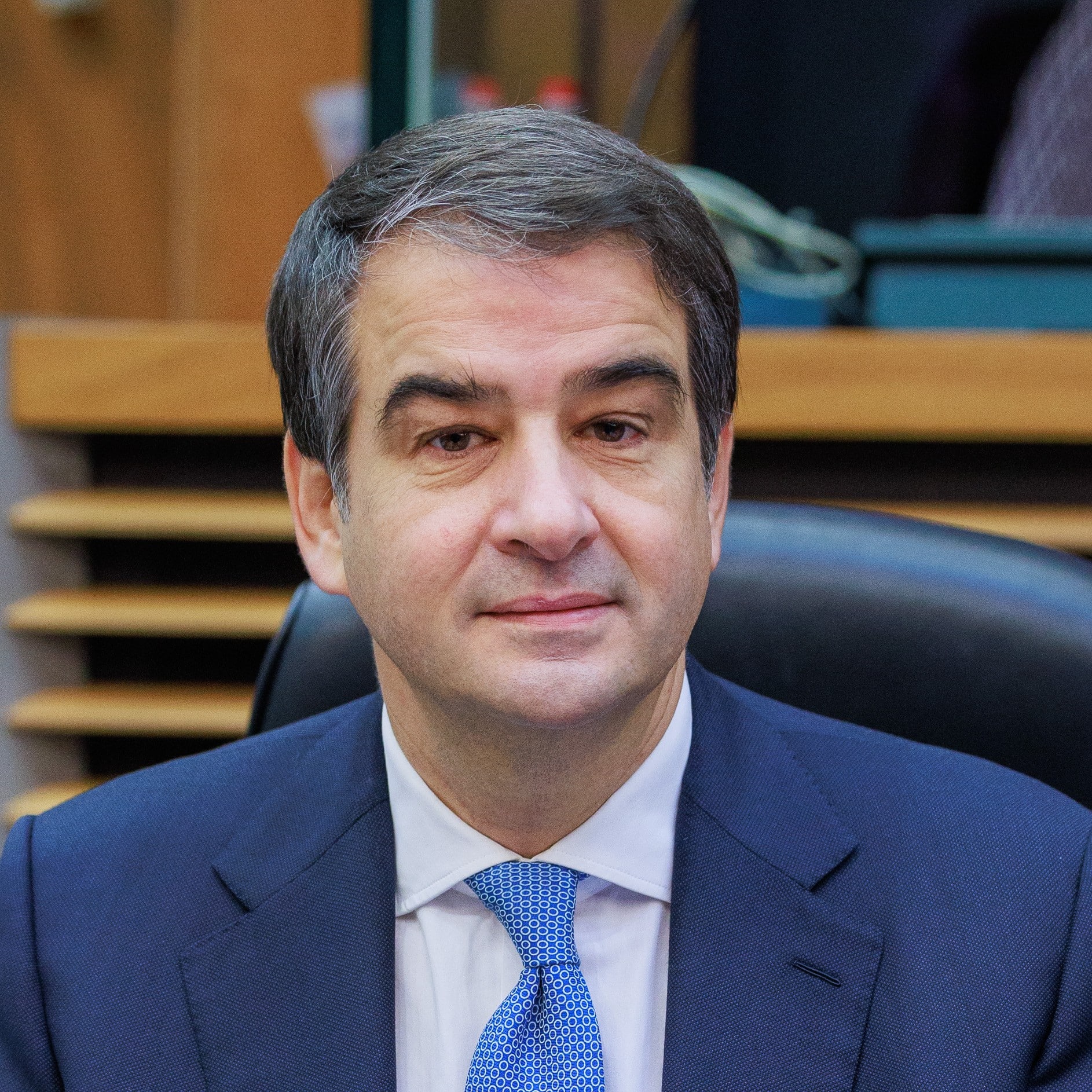
By Raffaele Fitto
As Executive Vice-President for Cohesion and Reforms, I am working closely with my fellow Commissioners to ensure EU policies reflect the territorial dimension and address urban needs directly.
Cohesion Policy is a key driver of competitiveness, resilience, and convergence. It has proven its value by supporting growth and jobs and reacting swiftly to major crises, from the pandemic to Russia’s war of aggression against Ukraine and the energy shock.
Between 2021 and 2027, cities are managing over €24 billion in EU investments. The European Urban Initiative promotes innovation, capacity building, and knowledge sharing, with more than 90 cities already benefitting. The projects support actions in areas such as the New European Bauhaus, sustainable tourism, and revitalisation in shrinking cities. URBACT strengthens transnational cooperation and backs cities in candidate countries and beyond.
Affordable housing is a political priority. It affects all income levels and regions. Cohesion programmes are investing €7.5 billion in housing, rising to €10.5 billion with national contributions. But this is not enough. I am committed to encouraging member states to double this figure and to mobilising private finance to meet our shared objectives.
To align with evolving needs, I am leading the modernisation of Cohesion Policy. This reform will better reflect new priorities and cities will be among the main beneficiaries, with more flexible and targeted support.
The upcoming Agenda for Cities will bring greater coherence to EU urban policy. It will build on tools like the European Urban Initiative and simplify access to funding, expertise, and partnerships for cities of all sizes.
Crucially, the Agenda will amplify the voice of cities in EU policymaking. Local governments are closest to citizens and know how policies play out on the ground. Their insights are essential, both to improve policy design and to help implement EU priorities effectively.
By working together — European institutions, member states, and local authorities — we will shape the cities of the future, ensuring they remain engines of progress and wellbeing for all our citizens.

By Raffaele Fitto
Executive Vice-President for Cohesion and Reforms, European Commission
Eurocities barometer – mayors’ edition
The Eurocities barometer tests mayors’ pulse on a range of trending topics. Based on direct insights from the 86 mayors who responded, this edition explores key themes such as trust in government, economic outlook, democratic satisfaction, fiscal autonomy, and access to EU funding.
Mayoral trust in other levels of government
This year’s survey highlights clear differences in how European mayors perceive regional, national, and EU institutions. Overall, national governments receive the lowest trust, while regional governments and the EU level receive higher levels of trust. Lack of trust with central government is a trend that is widespread across Europe, and that is directly linked with a centralisation trend and a perception of lost autonomy from local governments. Many mayors cite frustration with top-down decision-making, lack of municipal autonomy, and financial constraints imposed by central authorities. Some report higher levels of trust, often due to strong national-local alignment on issues like infrastructure, housing, or climate action.
Trust in the EU institutions is relatively strong but varies depending on the extent of city engagement in European programmes. Many cities value EU funding and policy alignment, seeing the EU as an important partner in areas such as climate action, mobility, and urban development. Cities that have better access to EU funds report higher trust. The ones that have more neutral or lower trust are the ones noting challenges of administrative complexity or low reactivity of EU decision-making. However, no city reports a complete lack of trust in the EU, suggesting that while frustrations exist, the EU is still viewed as a credible and necessary actor in urban governance, and an actor that cities expect to have more direct relations with that are not mediated by national governments.
Trust levels in different levels of government

Trust levels in different levels of government
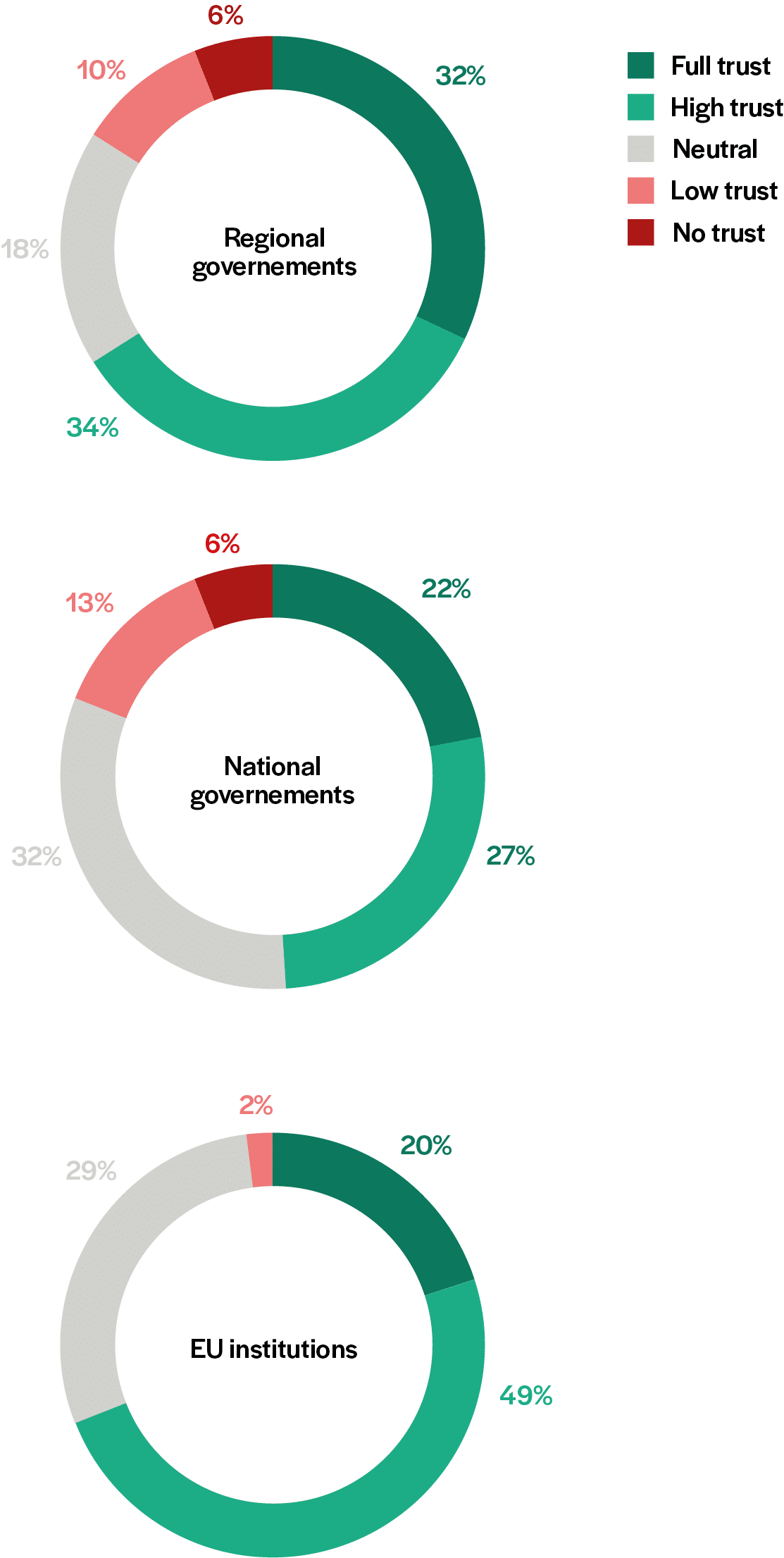
Confidence in democracy
Across Europe, mayors are upholding democracy, acting as the closest level of government to citizens and navigating political dynamics at both the national and EU levels. Their perspective on democratic governance offers a critical insight into the state of democracy in Europe. The responses reveal a mixed but hopeful picture: while confidence in the EU’s democratic system remains relatively strong, many mayors express deep concerns about the functioning of democracy at the national level. This contrast highlights the need to bridge the gap between national governments, EU institutions, and the cities that are at the heart of European democracy.
Geographic patterns reveal important trends. Mayors in Nordic and Western European cities tend to express moderate to high satisfaction with democracy, whereas some Central and Eastern European cities report strong concerns. Unsurprisingly, cities that report highest concern are those that represent different political parties to that of their national government. In Ukraine, where cities such as Zhytomyr and Irpin have been at the forefront of democratic resilience, mayors rate EU democracy highly, reflecting the importance of the EU’s role in supporting their stability and governance.
Mayor satisfaction with democracy in country vs. EU

A key finding from the survey is that mayors generally see the EU’s democratic model as stronger and more stable than their national governments. Many city leaders acknowledge the EU’s role in providing long-term vision, political stability, and institutional reliability.
At the national level, concerns over democracy are driven by political instability, budgetary centralisation, and limited influence of cities in national decision-making.
These findings point to a pressing need to reinforce democracy at all levels of governance. While many mayors express optimism about the EU’s democratic system, there is a clear demand for deeper local engagement and stronger urban participation in European policymaking. Addressing the concerns raised at the national level – particularly around centralisation, political instability, and financial constraints – will be essential to ensuring that cities can continue to act as pillars of democratic governance across Europe.
Mayor satisfaction with democracy in country vs. EU
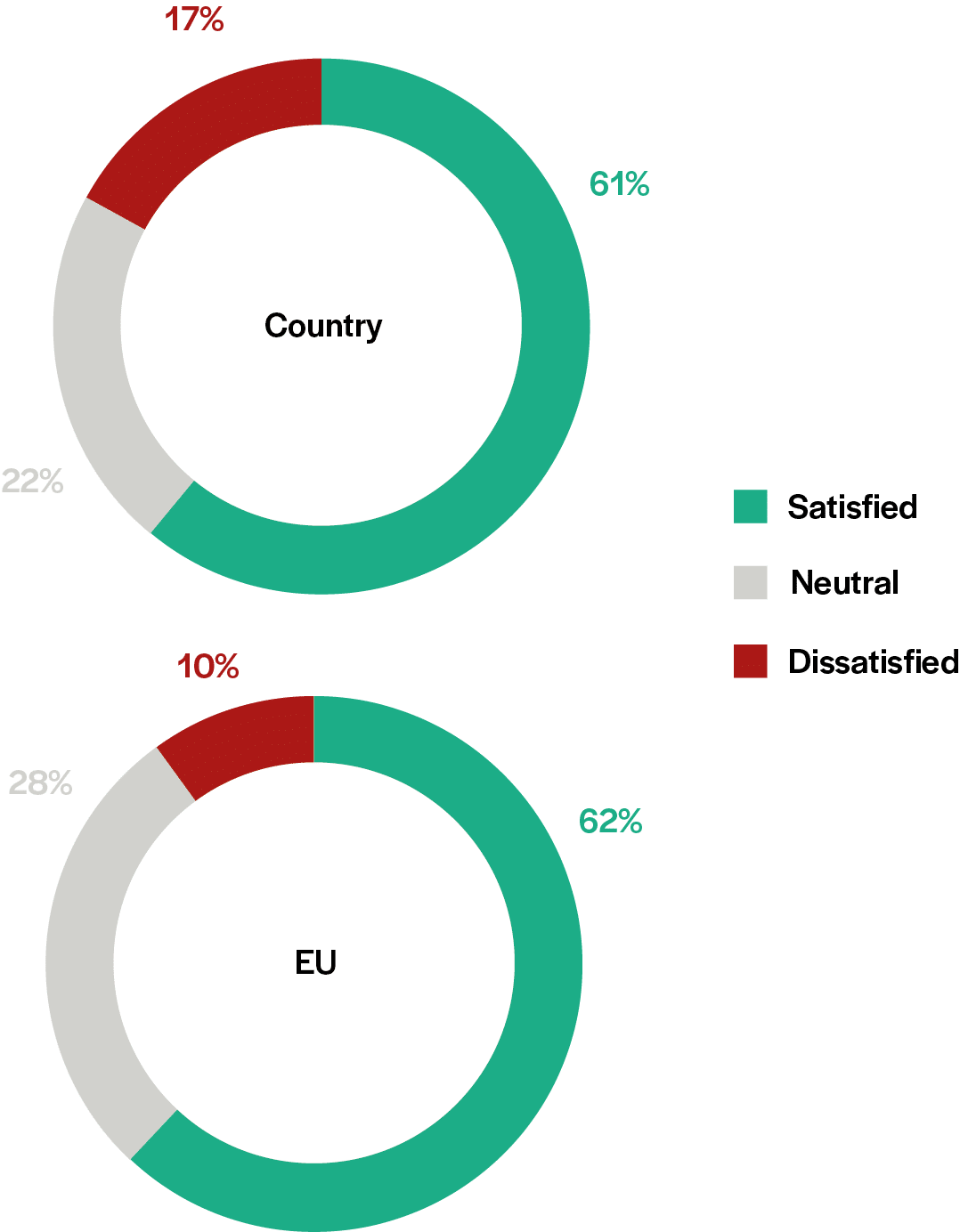
Sentiment about the future of the EU

The responses from mayors across European cities indicate a generally positive outlook on the future of the European Union. Using a sentiment scale from 0 to 10, where 0-3 reflects pessimism, 4-6 indicates a neutral stance, and 7-10 represents optimism, the results show that the vast majority of mayors remain confident in the EU’s trajectory. It is not surprising that mayors call for a strong alliance with EU institutions backed by an ambitious policy agenda for cities.
Mayor satisfaction with democracy in country vs. EU
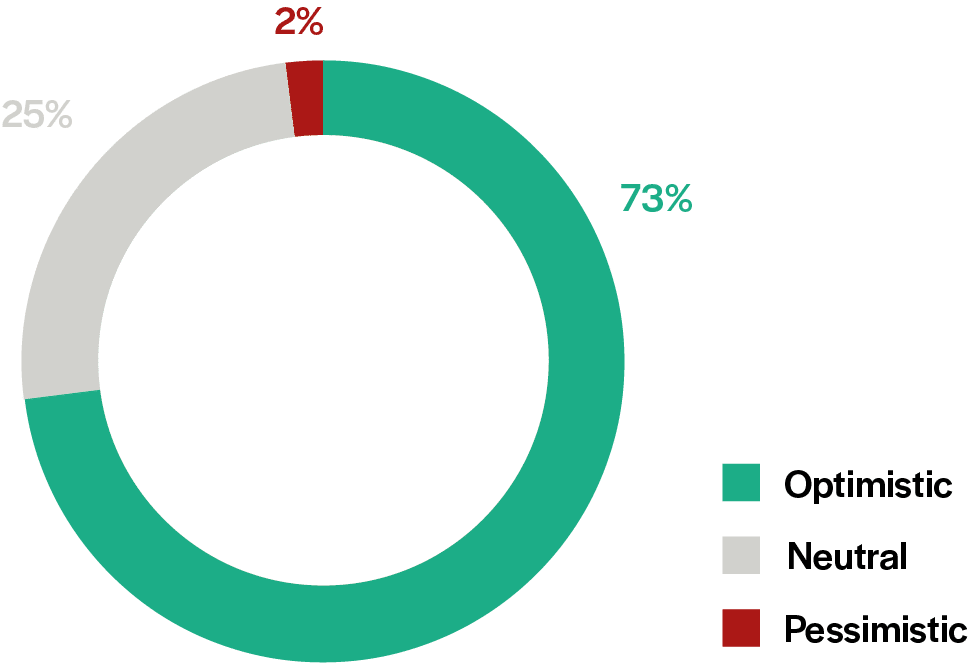
The overall sentiment is largely optimistic, with 73% of mayors rating their optimism between seven and ten. Neutral perspectives account for 25%, while pessimism remains rare, with only 2% of mayors expressing low confidence in the EU’s future. These results suggest that city leaders continue to see the EU as a key partner for urban progress, investment, and governance, despite existing challenges.
Cities in Western and Southern Europe tend to be the most optimistic while cities in Eastern and Northern Europe tend to be less so. Several key factors appear to shape mayoral optimism. Cities that are heavily involved in EU-funded projects and economic integration tend to report higher levels of confidence. Political alignment and decentralisation also plays a role.
Comparing these findings to broader public sentiment, mayors tend to be more optimistic than EU citizens. According to recent Eurobarometer data, 62% of European citizens express optimism about the EU’s future, compared to 73% of mayors in this survey. While 11% of citizens report pessimism, only 2% of mayors share the same view. The gap between citizen and mayoral sentiment may be explained by the fact that mayors work directly with EU institutions, funding programmes, and city partnerships, giving them a more pragmatic and engaged perspective on European cooperation. In contrast, citizens may view the EU through the lens of national politics or media narratives, which can create a more sceptical outlook.
The correlation between trust in the EU and optimism about its future is statistically significant suggesting a moderate positive relationship: mayors who have higher trust in EU institutions are more likely to be optimistic about its future. This reinforces the idea that institutional trust plays a key role in shaping mayoral perspectives on the EU’s future.
Looking ahead, these findings suggest that mayors see the EU as a critical force for urban progress, investment, and governance. Mayors’ strong optimism highlights their role as key advocates for European cooperation and integration, ensuring that cities continue to be central actors in shaping the EU’s long-term resilience and development.
Optimism about the future of the EU: Mayors vs. EU citizens
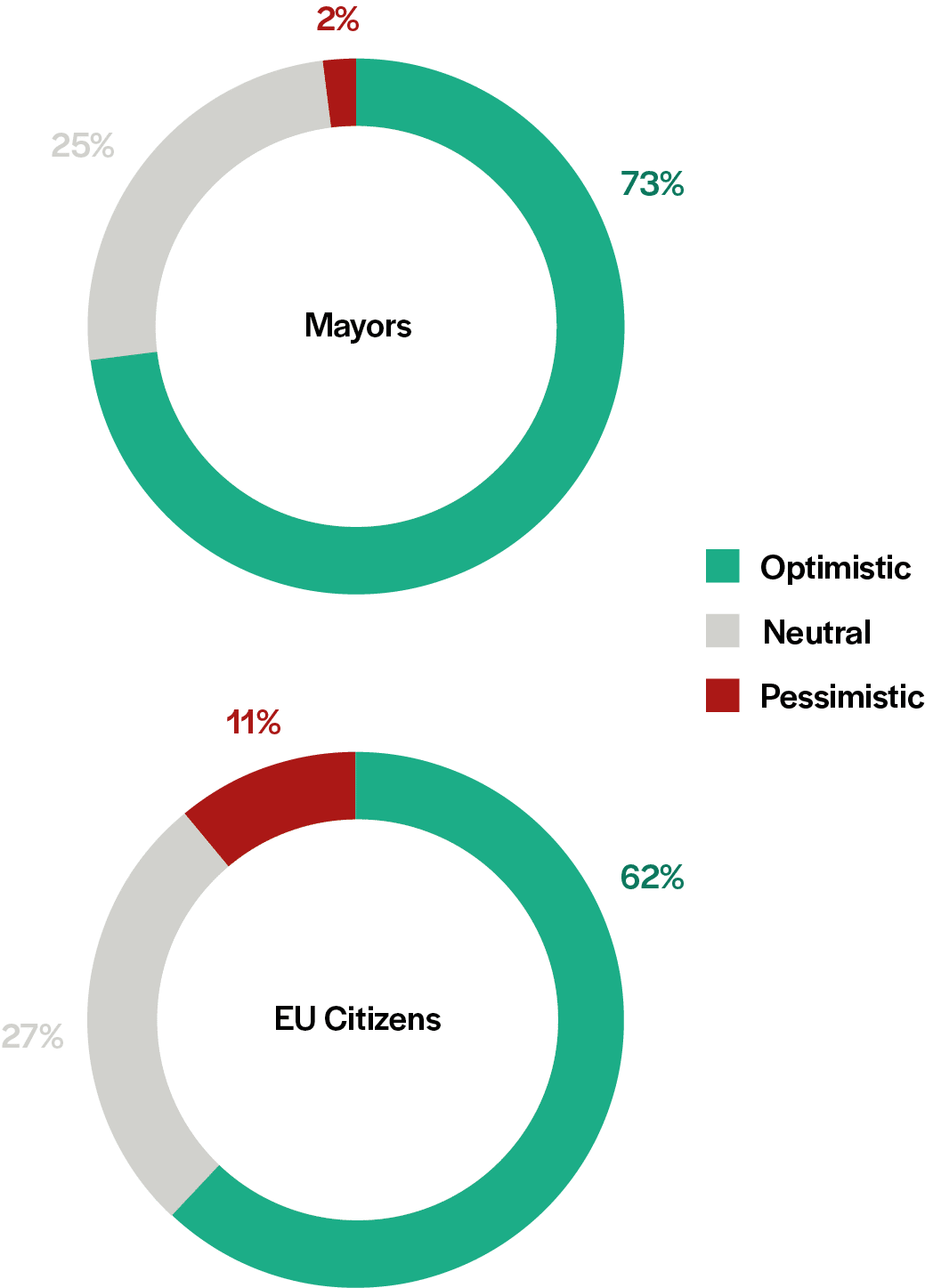

Economic outlook for 2025
The economic sentiment among mayors highlights a clear divide between how they perceive their local economies and the broader national economic landscape. While the majority of mayors remain confident about their city’s economic future, their views on national economies are more neutral or negative.
When rating their local economies, 64% of mayors gave high scores between seven and ten, reflecting strong optimism and a positive outlook. Many city leaders see urban economies as resilient, innovation-driven, and better positioned to navigate economic challenges than their national counterparts. In contrast, when assessing their national economies, responses were more cautious, with around half of mayors (50%) giving scores between four and six, indicating uncertainty and a more neutral outcome. A smaller number (19%) rated their national economies below four, pointing to concerns about economic stagnation, inflation, and budgetary constraints.
Distribution of economic outlook: city vs. Country
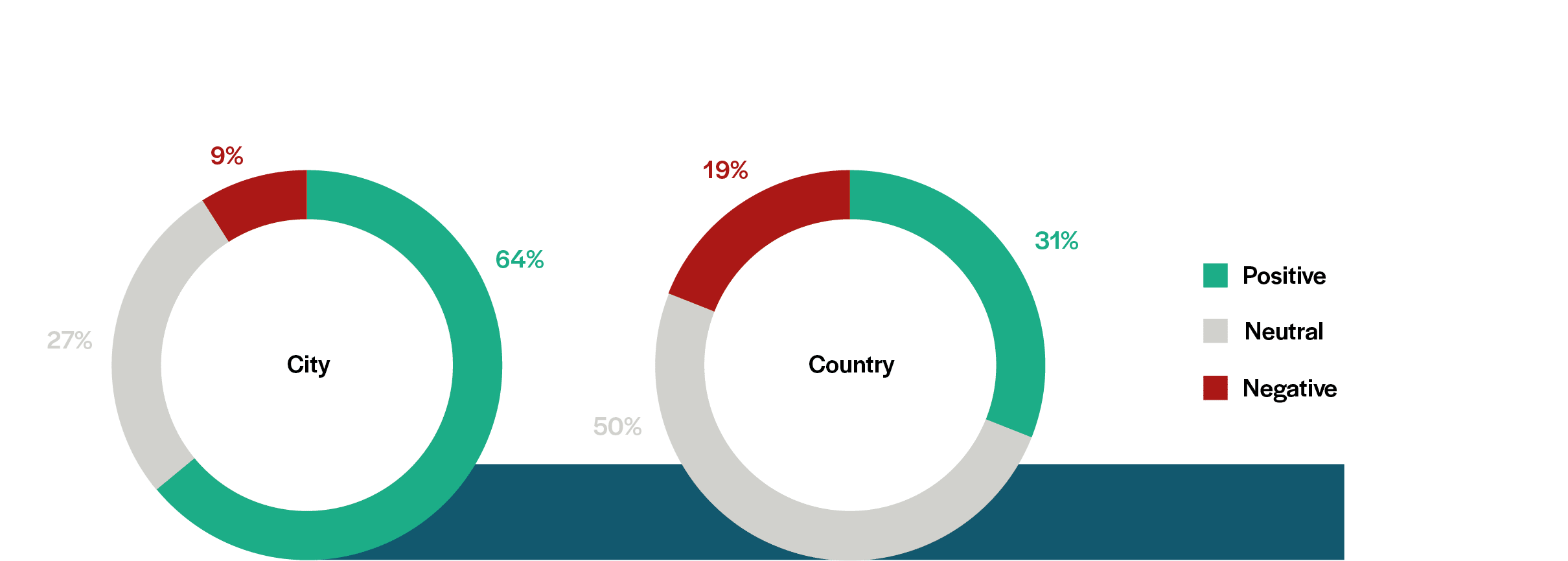
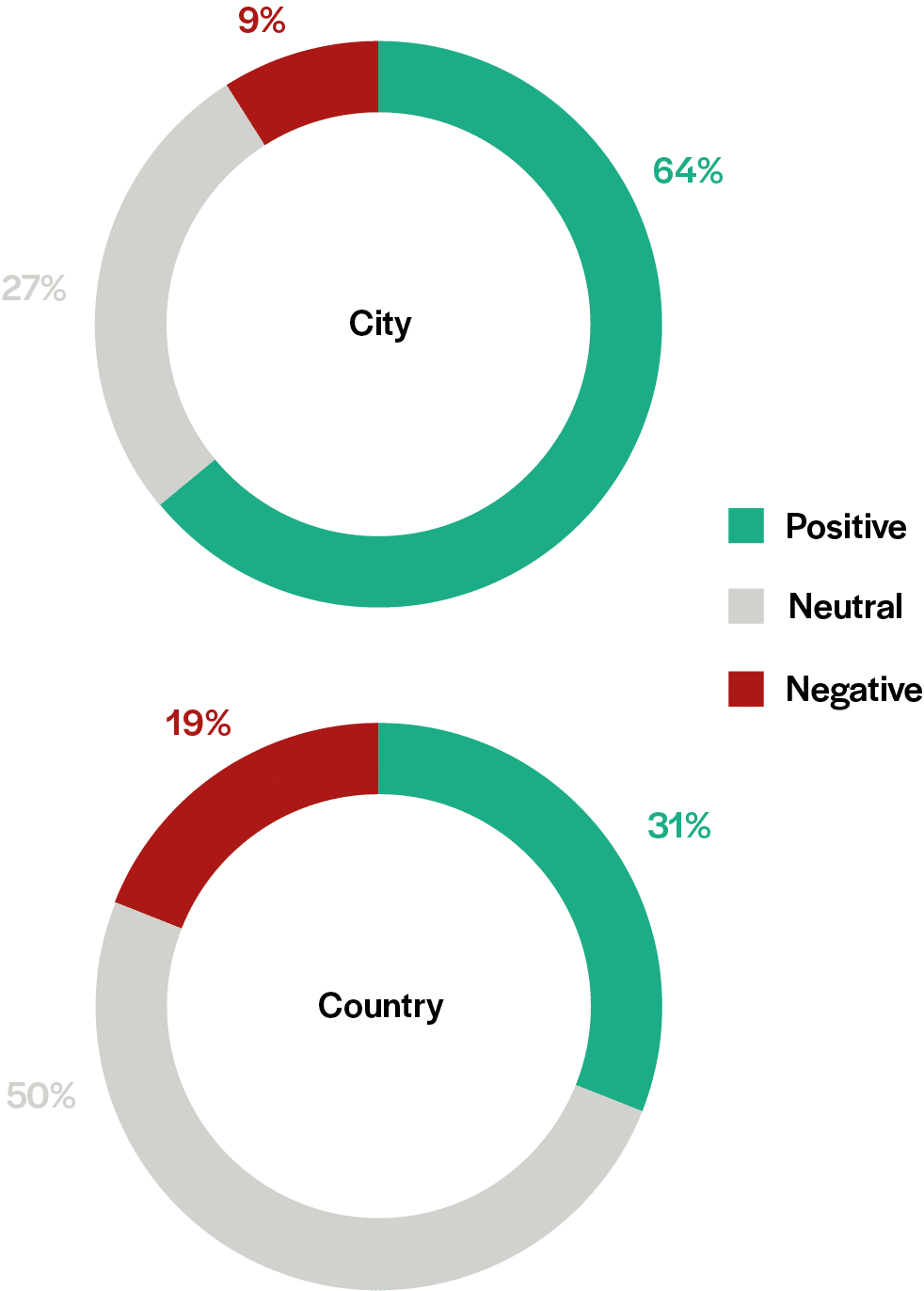

This divide is particularly evident in cities that report strong local economic confidence despite national economic pessimism. These cities are key economic engines, benefitting from strong local investment, innovation hubs, and urban-led policies that stimulate growth. However, they remain concerned about wider economic conditions, such as national-level policy stagnation, inflationary pressures, and slow fiscal reforms.
In contrast, some cities report aligned economic sentiment, where mayors rate both their local and national economy with similar scores. This suggests a more stable economic outlook, where national policies support local development, and macroeconomic conditions remain favourable. Cities such as Barcelona, Braga, Vienna, Gdansk, and Essen fall into this category, reflecting perceptions of both strong local governance and national economic stability.
A smaller group of cities express pessimism about both their local and national economies. These cities face significant financial pressures, including economic stagnation, fiscal constraints, or external shocks such as war or climate hazards, inflation, or the decline of key industries.
Looking at broader economic perspectives, mayors’ trust in the economy remains strong. However, when compared to similar surveys of business leaders, there is a notable divergence in economic sentiment. While mayors focus on city-level resilience and investment, business leaders tend to express more caution about Europe’s overall competitiveness and economic outlook.
Where mayors overwhelmingly see the EU as a source of investment and financial support, business leaders are more likely to highlight regulatory burdens and concerns over global trade competitiveness. This contrast suggests that while cities remain confident in their ability to drive economic success through local initiatives, broader European market dynamics and regulatory challenges shape a more cautious business perspective.
Multi-level cooperation and decentralisation
Effective governance in Europe relies on strong cooperation between local, national, and EU institutions. This year we explored mayors’ perceptions of cooperation across government levels, challenges in accessing funds, the degree of fiscal autonomy cities have, and their expectations from the EU on decentralisation.
Perception of cooperation across government levels
When asked about the cooperation with other levels of government over the past 10 years, nearly seven in ten mayors (69%) across Europe report an improvement in multi-level cooperation, reflecting a growing recognition of the importance of collaborative governance to address urban challenges. At the EU level, progress is evident through initiatives like the Urban Agenda for the EU and the enhanced urban dimension of Cohesion Policy. Nationally, as the OECD reported, governments are aligning urban actions through national urban policies, helping to create a more coordinated approach to urban development. Generally, there has been a broader acknowledgement of the crucial role cities play in tackling major challenges such as climate change, migration, and sustainable urban development.
However, despite these advances, there remains substantial room for improvement. While many cities have seen positive developments, a small but notable portion of mayors (7%) feel that cooperation has either declined or stagnated. These critical voices often come from regions where centralisation has increased, leading to challenges in engaging with national governments.
Multi-level cooperation across government levels
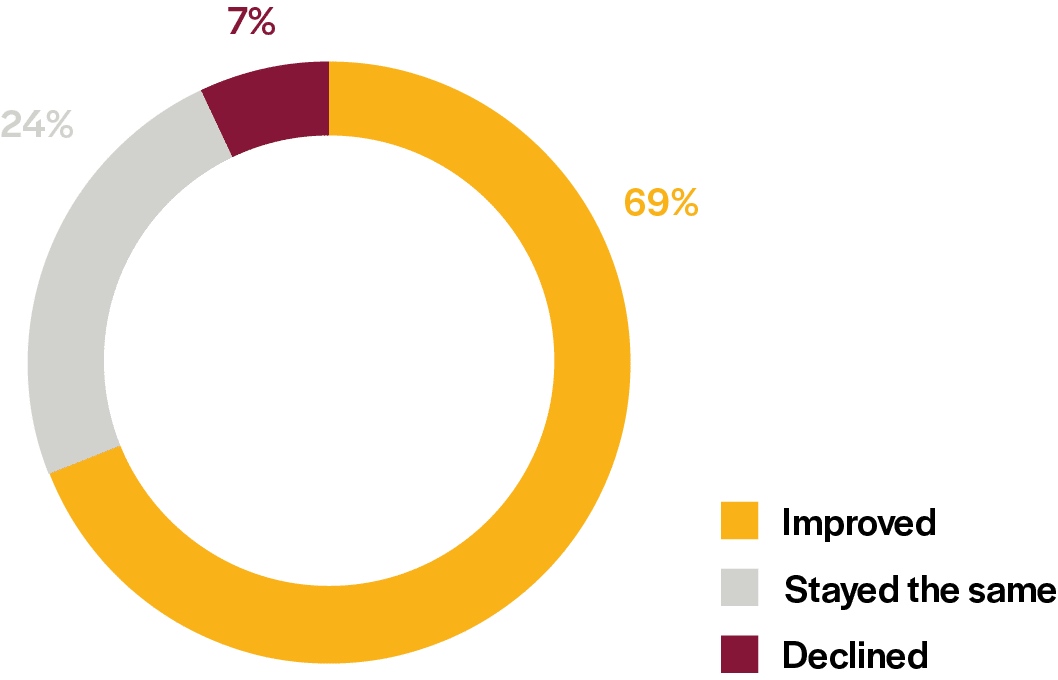
Access to funds from other government levels
Mayors’ perspectives on accessing funds from regional, national, and EU sources reveal major disparities in financial support for cities.
EU funding appears to be the most challenging financial source for cities to access. Only 33% of cities report ease in securing direct EU funding, with many citing complex application processes, slow approval mechanisms, and dependence on national intermediaries. Cities that have benefitted from direct forms of EU funding – either those who perceived easier access to Cohesion Policy and have higher envelopes or those who manage to secure direct funds through Horizon Europe or the European Urban Initiative – tend to have more positive experiences.
Access to national funding presents a more complex picture. Some mayors highlight political considerations as a barrier, with funding decisions sometimes influenced by national political dynamics rather than local needs.
Overall, regional funding is the most accessible for cities, with nearly half of respondents rating it as easy to obtain. The findings reinforce the need for more streamlined and direct financial mechanisms that allow cities to access funding efficiently.
City access to funding at regional, national and EU levels
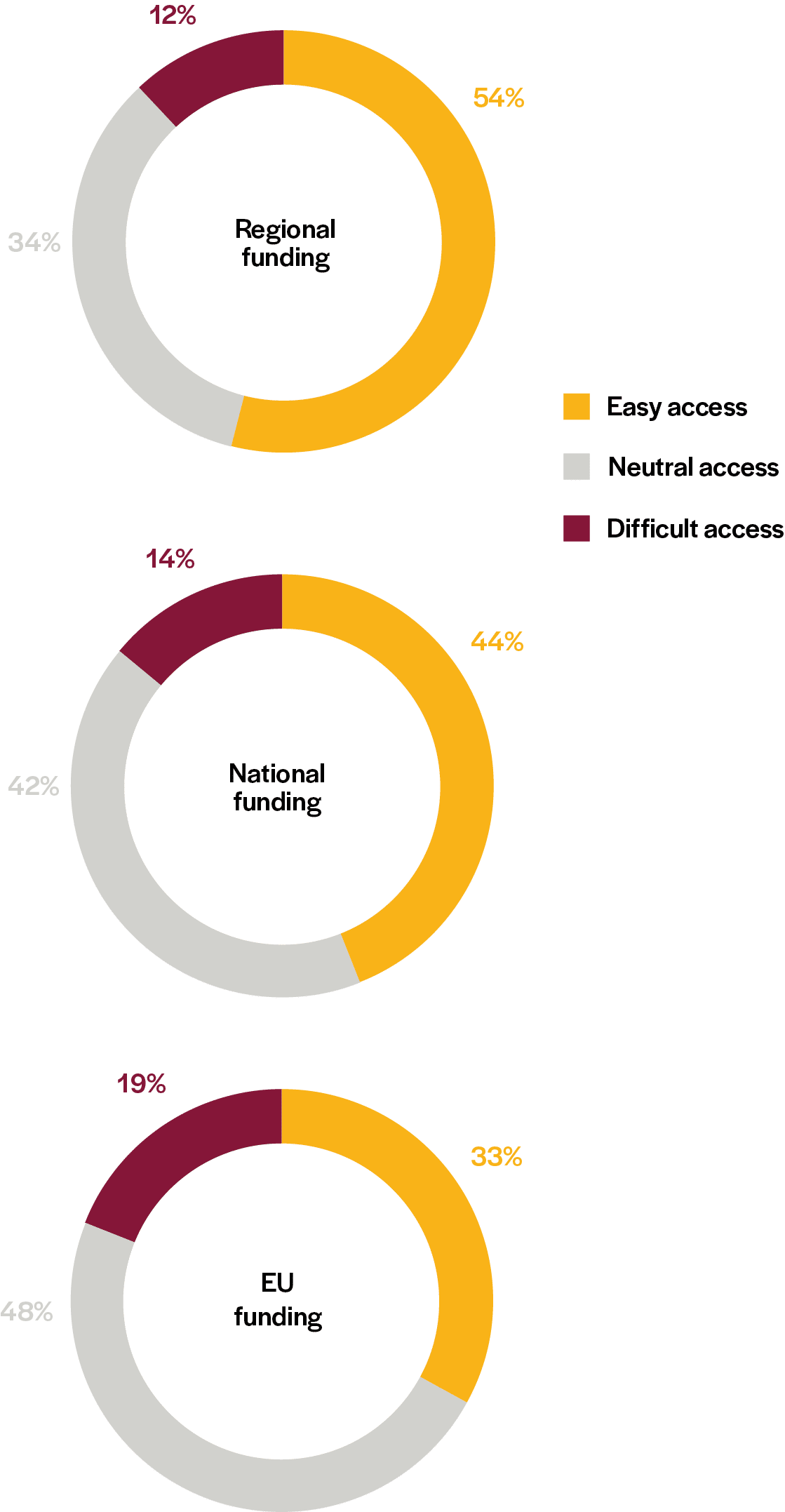

Fiscal autonomy in EU cities
Mayors’ perspectives on fiscal autonomy highlight major disparities in the financial independence of European cities. While some cities report strong control over their budgets, taxation, and investment decisions, many remain financially constrained, relying heavily on national and regional governments for funding. These limitations affect cities’ ability to implement long-term strategies and respond effectively to local challenges. Only 28% of mayors feel their city has high fiscal autonomy (scores 7–10), demonstrating that most local governments remain financially constrained in delivering strategic priorities.
This small group of cities, especially those with strong decentralised governance structures, such as in Switzerland, Germany, and the Nordic countries, indicate that they have the necessary fiscal tools to meet their objectives effectively. Their financial independence enables them to take decisive action on housing, infrastructure, and climate policies without waiting for approval or funding from higher levels of government.
However, nearly 20% of mayors (16 out of 86) report low fiscal autonomy (scores 0-3), highlighting that many cities struggle to collect and manage their own revenues effectively. These cities face severe restrictions on taxation powers, limited ability to raise independent revenue, and heavy dependence on national financial transfers that often come with strict conditions. Many mayors in this category express frustration with national policies that centralise financial control, preventing cities from responding flexibly to local needs. Some also highlight that national budget cuts or shifting political priorities have led to sudden reductions in municipal resources, further weakening their ability to invest in infrastructure, housing, and essential services.
Even among mayors with high optimism for the EU’s future, only a minority believe their city has the fiscal tools to implement key policies effectively.
The link between fiscal autonomy and trust in higher levels of government is also evident. Cities with low fiscal independence tend to have lower trust in their national governments. Mayors with high fiscal autonomy tend to be more optimistic about their city’s economic future and about the EU’s long-term prospects.
Distribution of fiscal autonomy among European cities
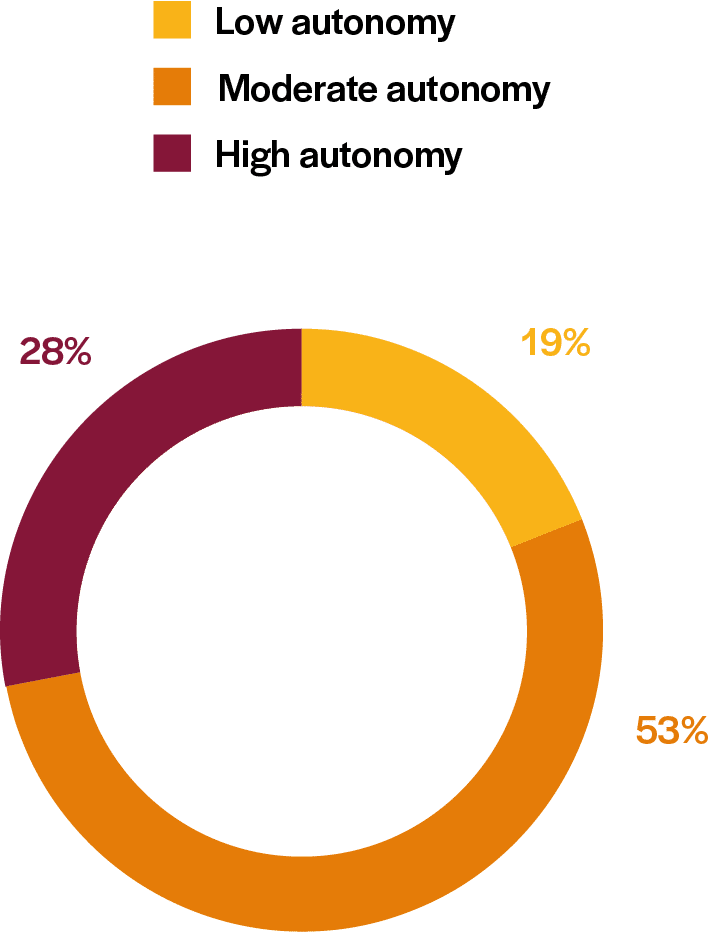
Expectations from the EU on promoting decentralisation

When asked what the EU should do to promote decentralisation, mayors across Europe are calling for the EU to take a stronger role in promoting it, ensuring that cities have the financial, political, and administrative tools needed to effectively address urban challenges.
Their expectations focus on securing direct funding, enhancing their role in EU decision-making, simplifying access to financial resources, and strengthening multi-level governance structures. Interestingly, these expectations are similar to the messages they put forward when asked how the EU could help them meet their priorities, suggesting that decentralising power and creating direct links with the EU is the most important reason.
Beyond what has already been mentioned, cities are also asking for legal and structural reforms that increase their fiscal autonomy. Many local leaders argue that their financial dependency on national governments limits their ability to plan and invest effectively. Mayors urge the EU to push for reforms that allow cities to retain more revenue from local taxation, such as property levies or tourism taxes, giving them greater control over their own budgets.
Government innovation and capacity-building are also high on the agenda and perceived as a way to boost decentralisation with mayors calling for dedicated EU programmes to support digital governance, smart city solutions, and training initiatives for local officials, equipping cities with the expertise needed to navigate future challenges.
For mayors, the message is clear: decentralisation is not just about shifting responsibilities – it is about ensuring that cities have the power, funding, and voice they need to drive Europe’s future.
Our duty is to be the optimists of Europe
The world today feels like a turning kaleidoscope – what once seemed stable is now in motion. Familiar patterns break apart. The future feels fragmented, unpredictable. But change is not only destruction – it is also creation. From disorder, new forms emerge. From broken pieces, new patterns take shape.

By Kata Tüttő
President of the European Committee of the Regions
The question for us as leaders, at every level, is: how do we shape this transformation? And how do we reduce the suffering that so often accompanies it?
Looking back, it seems the past five years – marked by crisis after crisis – were not just a series of disruptions, but a training season. A harsh, relentless preparation for where we find ourselves in 2025, and for what is yet to come. And now, it is time for us local leaders to push ourselves to the limit. To voluntarily step into responsibility, cutting a path through the growing chaos.
Europe’s greatest strength lies in being grounded in its local realities. When policies lose this grounding – when they become too complex, too abstract, too distant – trust erodes. And in times of growing distrust, the responsibility on local leaders increases. We must bring stability where there is uncertainty, and connection where there is fragmentation.
The role of the European Committee of the Regions is to connect European decision-making with the lived experiences of Europe’s cities, regions, and local communities – from mountain villages to industrial hubs, from coastal towns to rural farmlands. We digest and translate policy into something real. We bring local leadership, innovation, and common sense into the European process.
But what tools do we have?
Cohesion Policy is one of the EU’s most powerful stabilising tools – economically, socially, and territorially. It is the long-term glue that holds us together. But like all powerful tools, it needs constant calibration – guided by a sensitive signaling mechanism that comes from cities and regions.
If this tool becomes too bureaucratic, too rigid, too centralised – it fails.
Cohesion must flow – and it must flow in a stable, reliable way. Like blood in a living body, it must reach every part – the brain, the heart, the lungs, and the peripheries. Although resources exist, too often, the system is starving. The flow is blocked – by complex procedures, by lack of co-financing, by slow or rigid systems. Our task is to identify and remove those blockages.
That is how I evaluate any major EU policy – whether it’s about competitiveness, economic security, or innovation. I ask: will this improve the condition of the regions with the weakest circulation? Or will it make things worse?
It is tempting to believe that some policies are universally good. But every policy has a cost. Benefits and burdens are rarely distributed evenly. That’s why local and regional voices must be involved from the beginning – not as an afterthought.
We welcome the increased flexibility and the direct tools that allow us to invest in what matters most on the ground: affordable housing, water resilience, energy security, and local preparedness in times of crisis – including defence and all dimensions of security.
But no one should forget – even for a moment – that Cohesion Policy is not just a financial instrument. It is the structural investment that makes resilience possible in the first place.
Cohesion Policy must not become just an ambulance fund to patch the side effects of shifting priorities. It must remain the backbone of a strong, united, and balanced Europe. Because every time we take from it to respond to short-term pressures, it’s like pulling bricks from the foundation to reinforce the roof – sooner or later, the whole structure becomes unstable.
Local leadership is Europe’s untapped strength. And it is time to unlock it.
When the future feels uncertain, optimists are the ones who do everything in their power to shape it for the better. That is our duty – to be the optimists of Europe. To step forward. To take responsibility. To stay connected – to the ground, and to fellow local leaders across Europe. To bring innovation, courage, and common sense into decision-making.
By staying connected as local leaders, we strengthen the fabric of the European Union.

